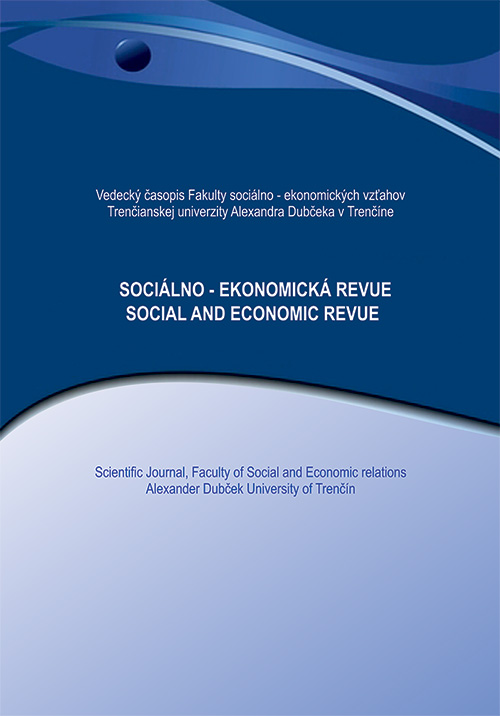EMPLOYMENT POTENTIAL VALUE OF OLDER PEOPLE IN THE COUNTRIES OF EUROPEAN UNION 28
Europe's aging population brought the need to cope with the challenges posed by use of employment potential of older people in the labor market. One of them is to monitor the development of key factors: employment, health, well-being and education, which encourage or suppress the use of employment potential. Employment potential value of older people in the European Union 28 in the years 2008-2018 is used to monitor the development of factors, on the basis of which the values of individual countries are determined by their ranking. Data are obtained from Eurostat and UNECE databases. Finland recorded the most significant shift in the ranking among the countries, mainly due to the growth of the education factor. Estonia had the largest drop, mainly due to the decline in the well-being level of older people. Visegrad group countries had a dichotomous development: Poland, Slovakia and Hungary rose in the ranking due to the growth of the education factor, while the Czech Republic fell sharply due to reduced well-being values.
Release: 2022/1 Pages: 5-11 JEL classification: E24, I00, I30, J14
DOI: https://doi.org/10.52665/ser20220101
Keywords: ageing, employment potential, labor market, older people
Section:
Contacts:
Jozef Bartek, Ing.
Faculty of Social and Economic Relations, Alexander Dubček University in Trenčín
Študentská 2, 91150 Trenčín, Slovakia
e-mail: jozef.bartek@student.tnuni.sk
Literature:
Abeysinghe, T. (2019). Old-age dependency: is it really increasing in aging populations? Applied Economics Letters, 26(13), 1111-1117.
Amber, D., & Domingo, J. (2017). Unemployment and job insecurity on people older than 45. Training challenges and educational implications. Revista Iberoamericana De Educacion, 73(1), 121-140.
Axelrad, H., Malul, M., & Luski, I. (2018). Unemployment among younger and older individuals: does conventional data about unemployment tell us the whole story? Journal For Labour Market Research, 52(1), 1-12.
Axelrad, H., Sherman, A., & Luski, I. (2020). The effect of employment on the subjective well-being of 60–80 years old people. International Journal of Social Economics, 47(12), 1481-1497.
Borchart, D., du Prel, J.-B., & Hasselhorn, H. (2021). Effects of health behaviors on the subjective employment perspective of older workers in Germany. Zentralblatt für Arbeitsmedizin, Arbeitsschutz und Ergonomie, 1-10.
Busygina, A. L., & Shtrikova, D. B. (2019). Unlocking the Female Employment Potential: Gender Aspect. In V. Mantulenko (Ed.), GCPMED 2018 - International Scientific Conference Global Challenges and Prospects of the Modern Economic Development. 57. Samara State Univ Econ, Samara, Russia: Future Acadpo Box 24333, Nicosia, 1703, Cyprus. pp. 1042-1054.
Ćwirlej-Sozańska, A., Wiśniowska-Szurlej, A., Wilmowska-Pietruszyńska, A., Sozański, B., & Woloszyn, N. (2018). Assesment of Psychological Capacities for Professional Work in Late Middle Age and at the Beginning of Old Age. Medycyna Pracy, 69(4), 375-381.
Dudel, C., & Myrskylä, M. (2017). Working Life Expectancy at Age 50 in the United States and the Impact of the Great Recession. Demography, (54), 2101-2123.
Ediev, D. M., Sanderson, W. C., & Scherbov, S. (2019). The inverse relationship between life expectancy-induced changes in the old-age dependency ratio and the prospective old-age dependency ratio. Theoretical Population Biology, 125, 1-10.
Eurostat. (2020). Ageing Europe — looking at the lives of older people in the EU — 2020 edition. (L. Corselli-Nordblad, & H. Strandell, Ed.) Luxembourg: Publications Office of the European Union. 179 p.
Eurostat. (2021a). Data Browser. [on-line] [cit.: 2022-22-04]. Retrieved from: Healthy life years by sex (from 2004 onwards): https://ec.europa.eu/eurostat/databrowser/bookmark/e1bb740a-579f-4dbe-a06e-25bdd1cee29e?lang=en.
Eurostat. (2021b). Data Browser. [on-line] [cit.: 2022-22-04]. Retrieved from: Life expectancy by age and sex: https://ec.europa.eu/eurostat/databrowser/bookmark/ce0353d6-6fda-4bf4-8b20-cc8f2bea3a7b?lang=en.
Eurostat. (2022). Data Browser. [on-line] [cit.: 2022-22-04]. Retrieved from: Employment rates by sex, age and citizenship (%): https://ec.europa.eu/eurostat/databrowser/bookmark/5add22c2-117a-4a4b-bcf9-246dbe024701?lang=en.
Fiala, T., & Langhamrova, J. (2017). Pension Age Which Would Guarantee Stabilization of the Old Age Dependency Ratio. In A. Gardon, C. Kozyra, & E. Mazurek (Ed.), Applications of Mathematics and Statistics in Economics Conference Proceedings. Szklarska Poreba, Poland: Wydawnictwo Uniw Ekonomicznego & Wroclawiuul Komandorska 118-120, Wroclaw, 53-345, Poland. pp. 117-132.
Gomezbellenge, F. X., & Belgrave, L. L. (1984). Unemployment Before Retirement - Gender And Racial-Differences. Gerontologist, 24(Si), 262-262.
Gregar, A., & Pejřová, I. (2013). Výkonový potenciál pracovníků 50+ a nová příležitost pro strategické řízení lidských zdrojů. In M. Seitl, & L. Vavrysová (Ed.), Sborník příspěvků z konference Psychologie práce a organizace 2013. Olomouc: Univerzita Palackého v Olomouci. pp. 185-193.
Gregar, A., & Pejřová, I. (2014). Pracovní potenciál pracovníků věkové skupiny 50+. In D. Fedáková, M. Bozogáňová, & L. Ištoňová (Ed.), Psychológia práce a organizácie 2014. Zborník príspevkov z 13. ročníka medzinárodnej konferencie. Košice: Spoločenskovedný ústav SAV. pp. 106-114.
Gregar, A., Pejřová, I., & Klímek, P. (2015). Pracovní potenciál starších pracovníků: jak personalisté mohou přispět?. In M. Rymeš, & I. Gillernová (Ed.), Mezinárodní odborná konference psychologie práce a organizace kvalita pracovního života. Praha: MATFYZPRESS, vydavatelství Matematicko-fyzikální fakulty Univerzity Karlovy v Praze. pp. 95-102.
Groot, W., & Van den Brink, H. (2000). Education, training and employability. Applied Economics, 32(5), 573-581.
Hallsten, M. (2012). Is it ever too late to study? The economic returns on late tertiary degrees in Sweden. Economics of Education Review, 31(1), 179-194.
Harris, K., Krygsman, S., Waschenko, J., & Rudman, D. L. (2018). Ageism and the Older Worker: A Scoping Review. GERONTOLOGIST, 58(2), E1-E14.
Hetschko, C., Knabe, A., & Schoeb, R. (2019). Looking Back in Anger? Retirement and Unemployment Scarring. Demography, 56(3), 1105-1129.
Horváthová, A., & Éhn, J. (2020). Analysis of the Expected Development of Demographic Factors and Their Adaptation to the Labor Market in Slovakia. Sociálno-ekonomická Revue (01), 40-50.
Hu, N., & Yang, Y. (2012). The Real Old-Age Dependency Ratio and the Inadequacy of Public Pension Finance in China. Journal of Population Ageing, 5(3), 193-209.
Hyndman, R. J., Zeng, Y., & Shang, H. L. (2021). Forecasting the old-age dependency ratio to determine a sustainable pension age. Australian & New Zealand Journal of Statistics, 63(2), 241-256.
Jeníček, V., & Foltýn, J. (2003). Globální problémy a světová ekonomika (1.. vyd.). Praha: C. H. Beck. 269 p.
Kim, J.-H., Song, A., Chung, S., Kwak, K. B., & Lee, Y. (2021). The Comparative Macro-Level Agism Index: An International Comparison. Journal of Aging & Social Policy, 33(6), 571-584.
Krajňáková, E., & Vojtovič, S. (2017). Struggles of Older Workers at the Labour. Economics and Sociology, 10(1), 319-333.
Lakomy, M. (AUG 2019). The effects of prolonged working life on subjective quality of life across Europe. Social Science Research, 82, 33-44.
Leitner, S. (2001). Sex and gender discrimination within EU pension systems. Journal Of European Social Policy, 11(2), 99-115.
Meliou, E., Mallett, O., & Rosenberg, S. (2019). Being a Self-Employed Older Woman: From Discrimination to Activism. Work Employment and Society, 33(3), 529-538.
Midtsundstad, T., & Nielsen, R. O. (2019). Lifelong Learning and the Continued Participation of Older Norwegian Adults in Employment. European Journal of Education, 54, 48-59.
Mirza, R. M., Mcdonald, L., & Tamblyn-Watts, L. (2021). It's Time to Retire Ageism against Older Workers. University of Toronto Quarterly, 90(2), 155-168.
Murray, E. T., Stafford, M., Shelton, N. J., Hagger-Johnson, G., Stansfeld, S., Zaninotto, P., & Head, J. (2015). Area Unemployment and Individual Health in Relation to Retirement and Sickness/Disability Transitions over 10 Years: Office for National Statistics Longitudinal Study. The Gerontologist, 55(Issue Suppl_2), 831–832.
Neary, J., Katikireddi, S. V., Brown, J., Macdonald, E. B., & Thomson, H. (2019). Role of Age and Health Perception of Returning to Work: a Qualitative Study. BMC Public Health, 496(19), 1-10.
Oskova, S. (2010). Gender Inequalities in the Labour Market. Proceedings Of The 8th International Conference On Economic Policy In The European Union Member Countries. Horni Lomna, Czech Republic: Silesian Univ Opava, School Business Administration Karvinauniverzitni Nam 1934-3, Karvina, 73340, Czech Republic. pp. 336-342.
Pawera, R., & Jančíková, E. (2017). An Issue of Age in the Labour Market in Slovakia. Economic Annals-XXI, 168(11-12), 93-99.
Ponomarenko, V., Leist, A. K., & Chauvel, L. (2019). Increases in wellbeing in the transition to retirement for the unemployed: catching up with formerly employed persons. Ageing & Society, 39(2), 254-276.
Shatalova, N. I. (1999). Sisteme Trudovogo Potentsiala Rabotnika. [on-line] [cit.: 2021-29-04]. Retrieved from: http://ecsocman.hse.ru/data/821/888/1216/007_shatalov.pdf.
Schelleman-Offermans, K., & Massar, K. (2020). Explaining socioeconomic inequalities in self-reported health outcomes: The mediating role of perceived life stress, financial self-reliance, psychological capital, and time perspective orientations. PLoS ONE, 15(12), 1-21.
UNECE. (2020). Active Ageing Index Home. [on-line] [cit.: 2022-04-04]. Retrieved from: III. Do it yourself!: https://statswiki.unece.org/pages/viewpage.action?pageId=76287845.
van der Mark-Reeuwijk, K. G., Weggemans, R. M., Bultmann, U., Burdorf, A., Deeg, D. J., Geuskens, G. A., . . . van der Beek, A. J. (2019). Health and prolonging working lives: an advisory report of the Health Council of The Netherlands. Scandinavian Journal of Work Environment & Health, 45(5), 514-519.
Vaňo, B. (2020). Dôsledky zmien reprodukčného správania na vekové zloženie obyvateľstva. Slovenská štatistika a demografia, 30(4), 3-12.
White, P. (2007). The future of older workers : New perspectives. (W. Loretto, & S. Vickerstaff, Ed.) Bristol: Policy Press. 237 p.
Whitley, E., & Popham, F. (2017). Leaving the Labour market Later in Life: How Does it Impact on Mechanisms for Health? Occup Environ Med, 74, 877-886.
Wuebbeke, C. (2011). The limitations of activation policies: unemployment at the end of working life. Ageing & Society, 31, 977-1002.
Zelezna, L., & Kreidl, M. (2016). Transitions between Employment and Unemployment among Older Workers in the Czech Republic. Sociologicky Casopis-Czech Sociological Review, 52(4), 505-533.


